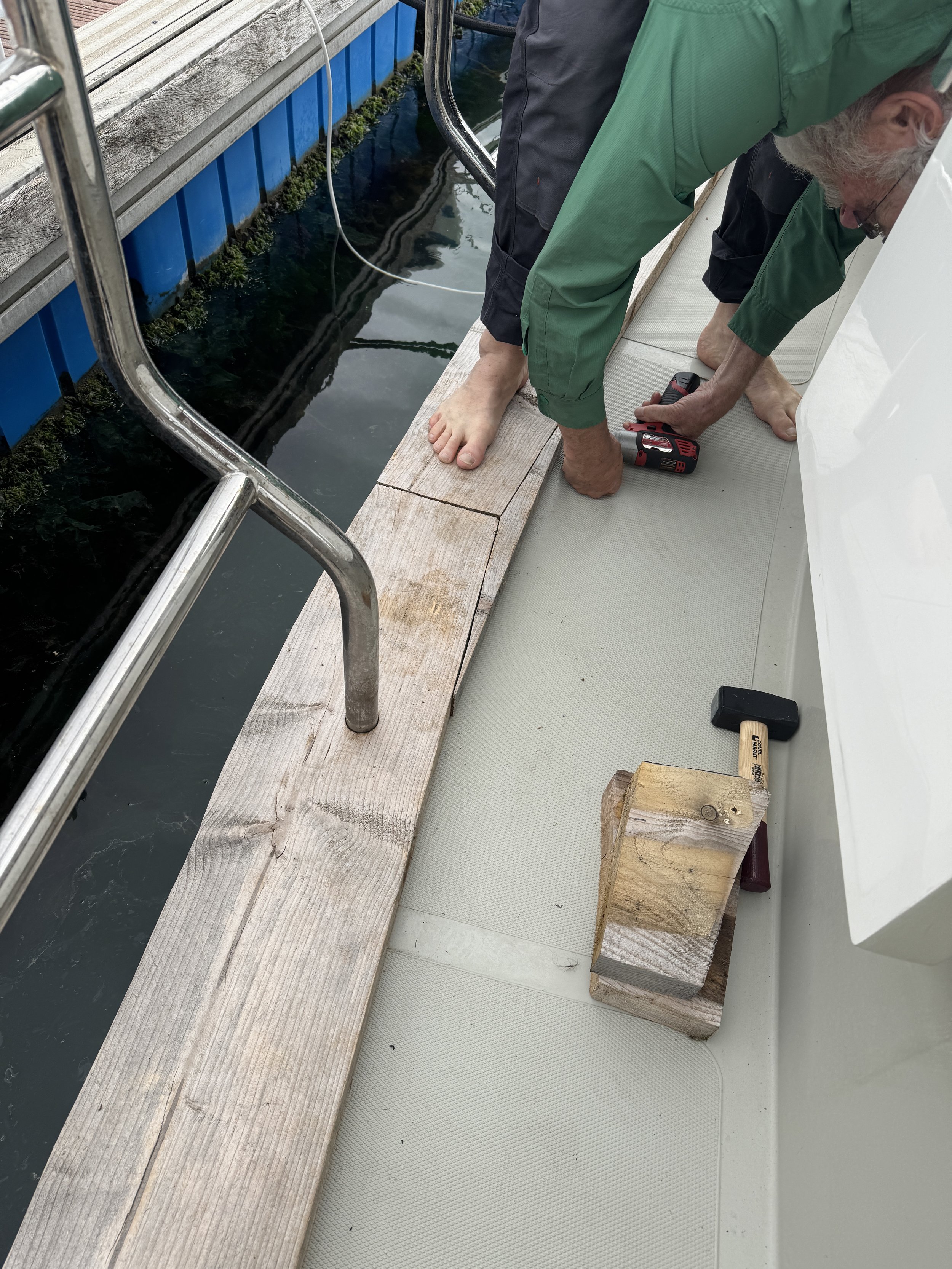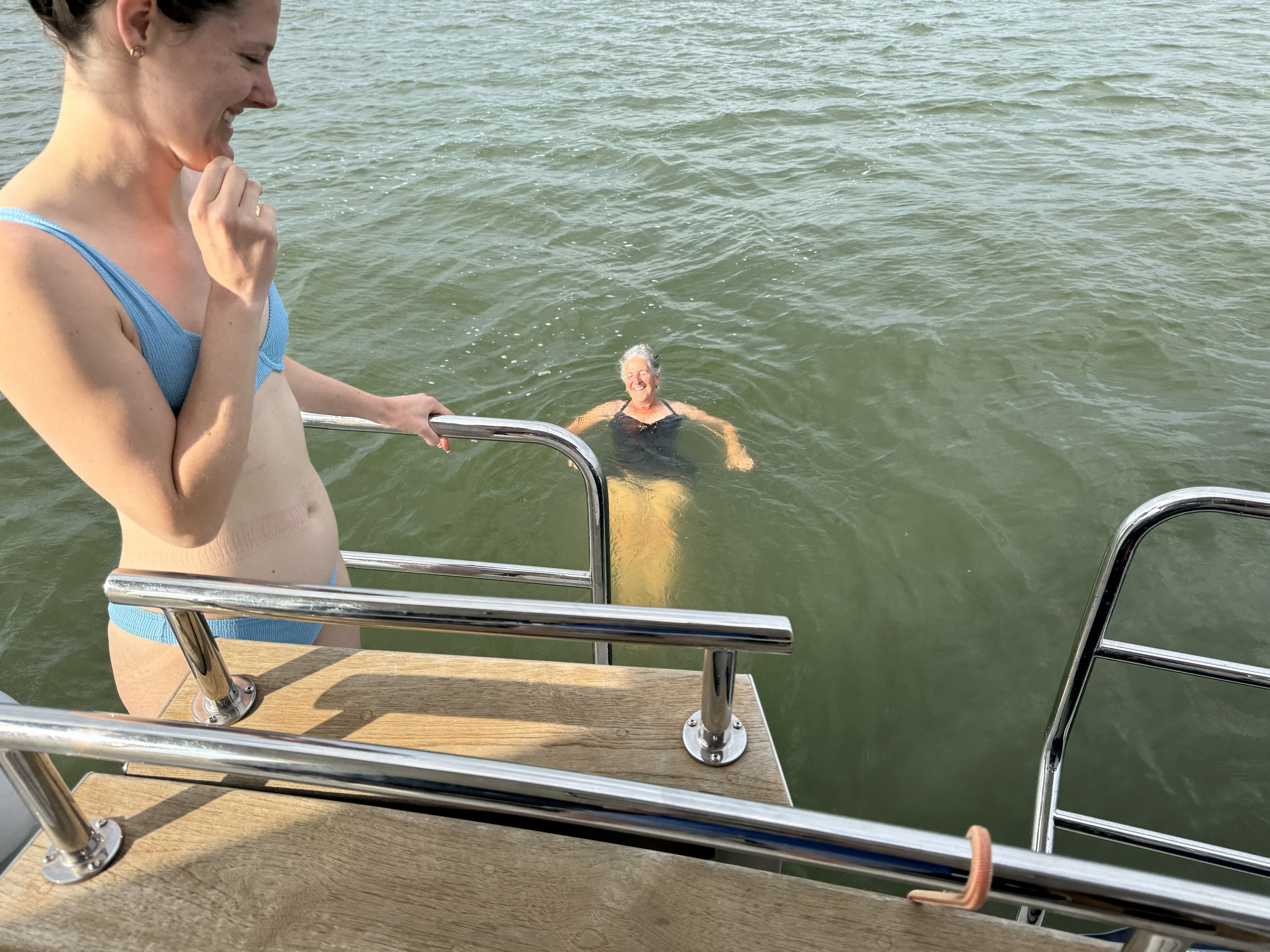Goodbye, France
In the Seine-Maritime area of the Normandy region of northern France is the major port city of Le Havre. Rebuilt after its destruction in World War II, just a handful of historic buildings in the city center survived.
Le Havre was a small fishing village until 1517. It was then enlarged and fortified in the 17th century, was adapted to accommodate bigger vessels in the late 18th century, and was further improved in the mid-19th century. The majority of traffic is imports, primarily crude oil and also ship repair and ferry services to England and Ireland. Linked directly to the port is the site of oil-refining, petrochemical, automotive, cement, and aeronautical-related industries. Today there is also a university and a growing tourist trade partly based on the yachting harbor.
We had planned to stay just a couple of days to dismantle the last remaining river modifications we no longer needed - remove the planks and dock fenders from the swim step, return the watermaker to normal operation after having been “pickled” (winterized) for long-term storage and to reprovision for our continued travels through the English Channel and into the North Sea. We completed our chores quickly but mother nature had something else in mind. We ended up waiting a full week for a storm to pass before departing. We used this time to walk the beach and the breakwaters, watch the local sailing schools perform drills, and observe the gulls working for their daily meals.











We had arranged to meet our “German children” in Amsterdam for the weekend and we we’re hoping we still had time to get there. The wind finally died down and we left the marina at daybreak the next morning heading north through the English Channel. Initially we’d planned a 14 hour transit, but the sea state was still quite confused after the storm and we were slogged by short one meter waves on our port beam for a couple of hours. Eventually the tide turned, the current switched directions and the waves settled. With the current now behind us we enjoyed a much smoother ride and Meraki picked up speed. Nevertheless we decided to call it a day by early afternoon and we ducked into the town of Dieppe at the mouth of the Arques River. We tied up across the dock from Le Français, a 47 meter (154 foot), three-masted barque sailing ship built in Denmark in 1948. It was once used to carry supplies to remote coastal settlements in East Greenland and is now used for educational purposes promoting maritime heritage and traditional sailing.
The coastline here is comprised of striking chalk and limestone cliffs and is known as the Alabaster Coast, or Côte d'Albâtre in French. Geologically similar to the cliffs of Dover, the Alabaster Coast is a well known hiking area with trails winding through port towns, along the headlands, down into small seaside villages and through dense forests of oak and beech trees.








We went for a walk around town that afternoon and discovered a sweet, bustling fishing port, with a lively fish market most known for its herring and scallops. Apparently Dieppe is considered the leading scallop fishing port in France.
We set off before dawn the next day passing through the Strait of Dover, the narrowest part of the Channel which connects the North Sea to the Western Atlantic, stopping briefly in Dunkerque after 15 hours of travel. The name Dunkerque originated from the West Flemish words “dun” and “kerke” meaning “church in the dunes”. Originally a fishing village in the 7th century and later a point of conflict between France, Spain, England, and Holland, it was briefly held by Dutch rebels before being regained by Spain, and was finally recovered by France in the mid 1600s. And of course, it was also the scene of the massive evacuation of over 338,000 soldiers rescued by a fleet of naval and civilian vessels during WWll. This operation, known as "Operation Dynamo", is a defining moment in the city's history.
There is much to see and do here but we needed to push on during the good weather if we wanted to reach Amsterdam in time for the weekend with our friends. Somehow it seemed fitting that this would be our final day in France.








It is only 10 kilometers (6.2 mi) to the Belgian border. and we arrived after a pleasant sail in the town of Blankenberge, population 20,000. At the end of the 19th century, due to the emerging spa tourism, this modest fishing village burgeoned into a trendy seaside resort in just a few decades. During this time beautiful villas and posh hotels were built. The town is also known for it’s Art Nouveau and Art Deco style which is noticeable in the architecture and signage throughout the old town. We enjoyed an evening stroll followed by a lovely dinner overlooking the marina.













The Belgian coast is a mere 65 kilometers long (40 miles) so before we knew it we had left Belgium and entered the Netherlands. We’re hoping to return to Belgium later in the year. We had now been in three countries in three days! (Thankfully there is no check-in/check-out protocol in these countries)
It was another very long travel day - over 14 hours, but we had secured a berth in the seaport at the entrance to the North Sea Canal, the main waterway connecting to Amsterdam.














The Netherlands is a country comprised of water; canals, ponds, lakes, rivers and the sea. In every region, every city, town and village there is a body of water nearby. Bridges in all forms are important here, and so are dikes and canal locks. In fact, over 25% of the land in the Netherlands is below sea level (it is the lowest country in the world).
The ingenuity of the Dutch people is reflected in their state of the art engineering technology. When there is an impending storm and the threat of rising water levels, the western part of the country that faces the North Sea is automatically shut down by a massive water lock and storm surge barrier system which closes automatically. This system is continually being evaluated and adapted to address the challenges posed by climate change and rising sea levels.
We entered the North Sea Canal through a lock, the few inch rise barely noticeable. It took about two and a half hours to transit the ~24 kilometers (13 nautical miles) to the city of Amsterdam. We had called ahead for a marina slip so we settled ourselves into our berth.
Amsterdam Centraal - Train Station
We did a few chores before walking to the ferry to meet our guests who had arrived by train from Köln, Germany. The central train station in Amsterdam is located right on the canal so you simply exit your train and board a ferry in a matter of minutes. The ferries run every 10 minutes or so to nine different locations and are all free.
That evening we walked to the NDSM Wharf neighborhood, a former shipyard located in north Amsterdam which has blossomed into a cultural hotspot in recent years. It has a vibrant artsy vibe with the Museum of Graffiti and Street Art and a variety of bars and restaurants. We had a great dinner in an industrial setting at a super lively place offering 34 beers on tap and seasonal food, and made a quick stop at the grocery store on the way home to pick up the required weekend Dutch specialities.













We headed northeast out of the city the next morning, through a lock, and into the Markermeer. This freshwater lake is 700 square kilometers (270 square miles) in size, with depths between two to four meters (6-13 feet).
In the middle of the Markermeer is the Marker Wadden, a relatively new nature reserve, part of the Nieuw Land National Park, made up of of seven different islands. The islands are manmade and until recently consisted only of silt, sand and clay that had been dredged from the lake bottom. The goal is to improve biodiversity and the ecosystem in the Markermeer. Recent research has shown that the water around the islands has become clearer and more and more life is developing both above and below the water.
Sound on!
The islands are now covered in vegetation and the natural habitat seems to be developing at a rapid pace. Boaters are permitted to visit the main island where there are walking trails, birdwatching huts and viewing screens, a lookout tower and a recreational beach. We anchored just off the beach and took the dinghy ashore for a walk and a little bird watching. Back aboard Meraki that evening we enjoyed a brisk swim - the first of the year, a yummy dinner and a game of cribbage.





















Sadly, the weekend ended all too soon and we needed to bring our friends back to Amsterdam the next day. It was an all too brief visit but delightful just the same. Good food, lots of laughs, deep conversation and so much love.



Note: photo captions will not appear if viewing on a cell phone.





